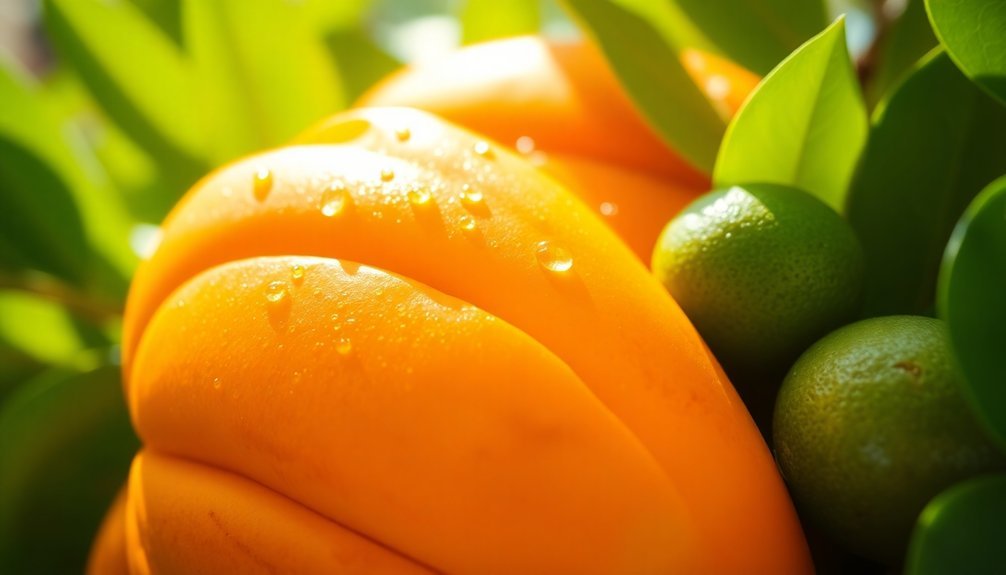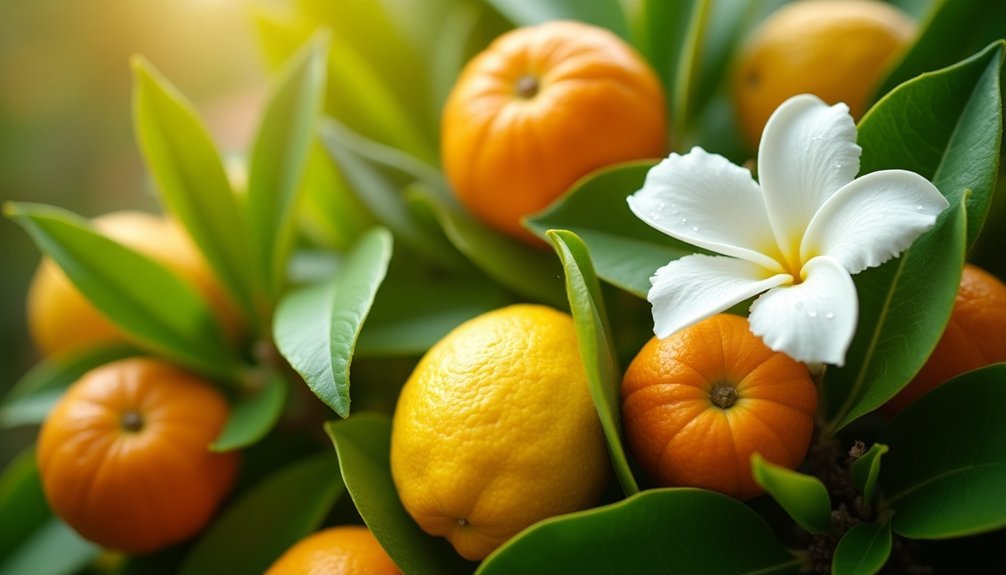The most effective tropical top notes in perfumes combine fresh citrus with sweet fruits like mango, guava, and pineapple. You'll find that Sicilian mandarin particularly enhances these tropical blends, while coconut pairs beautifully with white flowers for sophisticated depth. During summer, these notes project intensely and perform best when balanced with warm spices to prevent overwhelming sweetness. Understanding the interplay between natural and synthetic elements can transform your fragrance journey.
The Science Behind Tropical Top Notes

While perfumers have long understood the emotional impact of tropical scents, the science behind top notes reveals why these fragrances are so effective at capturing summer's essence.
When you experience tropical fruit notes like pineapple combined with fresh citrus, they instantly trigger positive emotions and memories of beach vacations. The balanced aroma comes from carefully layering these bright top notes with creamy chords, often derived from coconut's exotic element.
This sensory experience creates a complex fragrance that's both uplifting and sophisticated. You'll notice how summer imagery plays a significant role in the way these scents are perceived, as the combination of sweet and fresh notes mirrors the natural vibrancy of tropical environments.
It's this scientific approach to blending that makes tropical top notes so compelling.
Essential Tropical Fruit Combinations
When you're selecting tropical fruit combinations in perfumes, you'll find fresh citrus pairings create an energetic lift that enhances notes like pineapple and mango.
You'll notice coconut blends beautifully with white flowers, creating a sophisticated tropical accord that's become a classic pairing in modern perfumery.
The balance between sweet tropical fruits and warm spices is essential, as it prevents the fragrance from becoming overwhelmingly sugary while adding depth and complexity to the composition.
Fresh Citrus Pairings Work
If you're seeking to create the perfect tropical fragrance, you'll find that fresh citrus notes pair magnificently with tropical fruits.
Combining lemon, lime, and mandarin orange with pineapple and coconut creates vibrant, uplifting scents that'll transport you to a sunny paradise. These pairings work particularly well because citrus adds a zesty kick that prevents tropical combinations from becoming too sweet.
You'll notice how citrus elements enhance the invigorating quality of tropical fruits like mango and papaya, making the fragrance more suitable for summer wear.
This balance is essential for wearability, as demonstrated in popular scents like CK One, which masterfully blends pineapple with citrus top notes. The result is an energizing composition that remains lively without becoming overwhelming.
Coconut With White Flowers
The combination of coconut with white flowers stands as a cornerstone of tropical perfumery. You'll find this pairing in fragrances like Carolina Herrera's CH Birds of Paradise and Jean Paul Gaultier's Le Beau Paradise Garden, where the creamy richness of coconut enhances the fresh floral notes to create an exotic sensation.
When you're looking for the perfect summer scent, this combination delivers an appealing balance of sweetness and invigorating qualities. The coconut's indulgent qualities harmonize beautifully with white flowers like ylang-ylang and jasmine, evoking memories of sun-soaked vacations.
In perfumes like Kilian Paris's Sunkissed Goddess, this revitalizing blend captures the essence of a tropical getaway, making it an ideal choice for warm weather wear. You'll appreciate how these notes work together to transport you to a beachside paradise.
Sweet-Spice Balance Matters
Mastering sweet-spice balance defines the art of tropical fruit combinations in perfumery. You'll find that tropical fruits like mango, pineapple, and coconut create vibrant characteristics that enhance your fragrance profile while maintaining a delicate sweet-spice balance.
To achieve the perfect blend, you'll want to pair fresh citrus notes with tropical fruits. This combination amplifies brightness and freshness, especially in summer scents.
Adding creamy chords alongside coconut provides a sensual foundation that won't overwhelm your olfactory experience. For additional depth and complexity, consider incorporating exotic ingredients like ginger and ylang-ylang. They'll complement your tropical fruit selections while preserving that essential sweet-spice harmony.
You can see this balance at work in popular fragrances like CK One, where pineapple sweetness meets crisp citrus elements.
Natural Vs Synthetic Tropical Notes
Understanding the distinction between natural and synthetic tropical notes reveals a fascinating dichotomy in modern perfumery. You'll find that natural tropical notes, like coconut and pineapple, deliver an authentic fresh scent profile that's hard to replicate.
However, synthetic tropical notes offer remarkable consistency and staying power in your favorite fragrances.
When you're exploring gourmand fragrances, you'll notice how both natural and synthetic elements work together to create innovative blends.
While natural ingredients provide nuanced complexity, synthetic components enhance your olfactory experience through powerful projection and lasting sillage.
Your user preferences might draw you toward the authenticity of natural ingredients, but don't dismiss synthetic alternatives – they're essential in modern perfumery, offering stability and creative possibilities that complement their natural counterparts.
Seasonal Performance of Tropical Notes

You'll notice tropical notes perform differently as seasons change, with their vibrancy peaking in summer's heat and humidity while becoming more subdued in winter's cold.
In summer conditions, fragrances with pineapple and mango notes project more intensely and create a revitalizing effect that matches the season's mood.
The interaction between tropical notes and humidity can affect both the projection and longevity of your fragrance, making these scents particularly effective for warm-weather wear.
Summer Heat Performance
When summer temperatures soar, tropical top notes in perfumes truly come into their own. You'll find that notes like pineapple, coconut, and mango deliver a revitalizing burst that's perfect for those hot summer months. These vibrant characters shine brightest during outdoor activities and beach vacations, making them essential additions to your fragrance collections.
| Tropical Note | Best For |
|---|---|
| Pineapple | Beach Days |
| Coconut | Pool Parties |
| Mango | Garden Events |
| Passion Fruit | Evening Soirées |
The heat amplifies these tropical notes, creating an uplifting experience that resonates with warm-weather activities. When you're looking for a perfume that performs well in summer conditions, these exotic fruits provide the perfect balance of sweet and fresh characteristics, ensuring you'll stand out in the best way possible.
Winter Vs Summer Notes
The stark contrast between winter and summer fragrances becomes evident in how tropical top notes perform across seasons.
You'll notice that summer fragrances embrace vibrant olfactory experiences through fruity fragrance combinations, while winter fragrances lean towards warmer, deeper elements.
While gourmand fragrance collections now feature tropical top notes year-round, they're most effective during warmer months.
- A pineapple note bursts with sunshine-filled energy on hot summer days
- Fresh unisex appeal shines through coconut milk accords in beachy blends
- Mango creates a juicy, bright effect that's perfect for summer evenings
- Winter formulations favor spicier, heavier notes over tropical freshness
This seasonal difference isn't just about preference – it's about how these notes perform in different temperatures and how they align with our emotional connection to each season.
Humidity Impact Analysis
Humidity levels profoundly shape how tropical top notes perform in different seasons.
You'll notice that in high humidity environments, fruity and creamy notes like pineapple and coconut become more prominent and engaging. This enhanced scent projection creates a more vibrant olfactory experience, especially when tropical fruits are paired with citrus elements.
During the summer season, when humidity is at its peak, you'll find these invigorating notes particularly appealing.
While the longevity of tropical fragrances may be shorter in humid conditions, they deliver an immediate and enchanting scent profile that's worth the trade-off.
The sweet and energetic characteristics of ingredients like mango and guava shine through the moisture-rich air, making them ideal choices for creating that perfect summer ambiance you're looking for.
Balancing Sweetness With Citrus Elements

Creating harmony between sweet tropical fruits and zesty citrus elements stands at the heart of successful tropical perfume formulation.
You'll find that tropical top notes like pineapple and mango bring warmth and juicy sweetness, while citrus notes provide the perfect counterbalance. This interplay creates a multi-dimensional scent that captures summer freshness without becoming overwhelming.
- Picture yourself on a sun-drenched beach, where fresh-cut pineapple meets zesty lime
- Imagine the burst of Sicilian mandarin complementing sweet mango nectar
- Envision tropical cocktails garnished with citrus wedges on a warm evening
- Visualize dewy fruit baskets filled with both tropical and citrus fruits
The key to successful fragrance formulation lies in striking the right balance between these elements, ensuring your perfume remains fresh and inviting rather than cloying.
Longevity Factors in Tropical Accords
Understanding longevity remains vital when working with tropical accords in perfumery. Higher concentrations of essential oils greatly boost your fragrance's staying power, helping those fleeting top notes last beyond their typical 30-minute to 2-hour window.
You'll find that fragrance performance depends on several key factors. Base notes like woods and ambers help anchor your tropical accords, while personal skin chemistry directly impacts how long the scent lingers.
Your skin's hydration levels and pH balance play important roles in determining the fragrance's duration. Environmental factors, particularly warmth and humidity, can either enhance or diminish your perfume's longevity.
While warm conditions may initially amplify tropical notes' diffusion, they can also speed up evaporation, so you'll want to take these elements into account when choosing and applying your fragrance.
Frequently Asked Questions
What Are the Best Perfume Notes for Hot Weather?
You'll feel refreshed in hot weather with citrus-based fragrances like lemon and mandarin. Add tropical fruits, coconut, light florals, and marine notes for the perfect summer scent that'll keep you cool.
What Is a Tropical Scent?
A tropical scent's what you'll find in warm-weather fragrances featuring sweet, exotic fruits like pineapple, coconut, and mango. It'll transport you to sunny beaches with fresh, uplifting notes that capture paradise's essence.
What Are the Best Top Notes for Perfume?
For the best perfume top notes, you'll want bright citrus like bergamot and lemon, fresh florals such as lavender, or crisp herbs like mint. These notes create an immediate, uplifting first impression.
What Is the Most Attractive Smell in Perfume?
You'll find tropical scents like coconut, pineapple, and mango are consistently rated as most attractive in perfumes. They'll remind you of warm beaches and summer fun, creating an irresistible, inviting aroma.
In Summary
You'll find that tropical top notes work best when you carefully balance their inherent sweetness with bright citrus elements. Whether you choose natural or synthetic compositions, combining fruits like mango, pineapple, and passion fruit creates vibrant, memorable fragrances. For peak performance, consider your climate and season, and remember that proper layering with middle and base notes guarantees your tropical accords last longer on the skin.





Leave a Reply